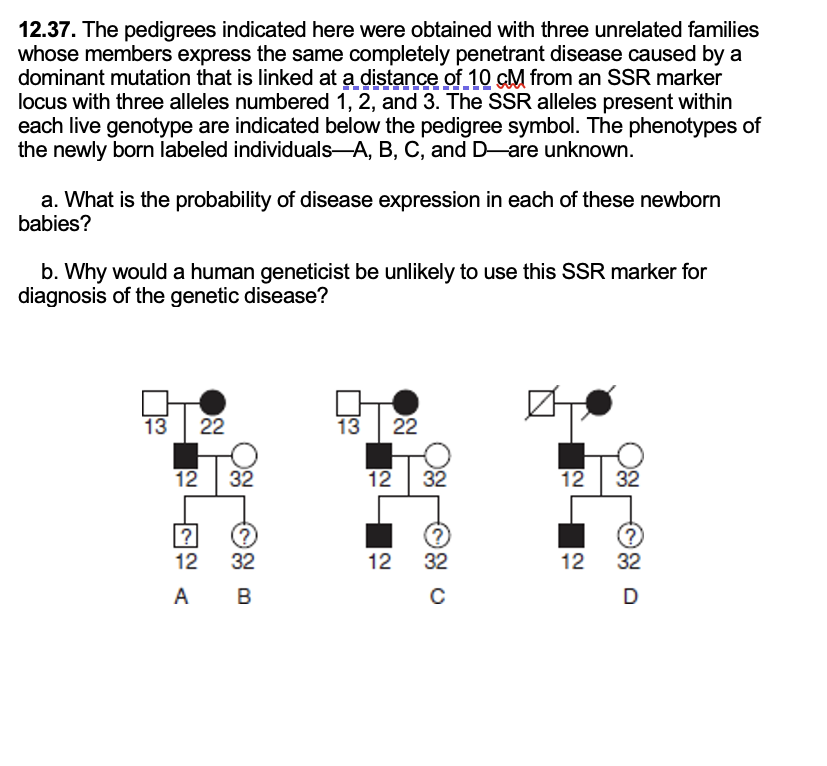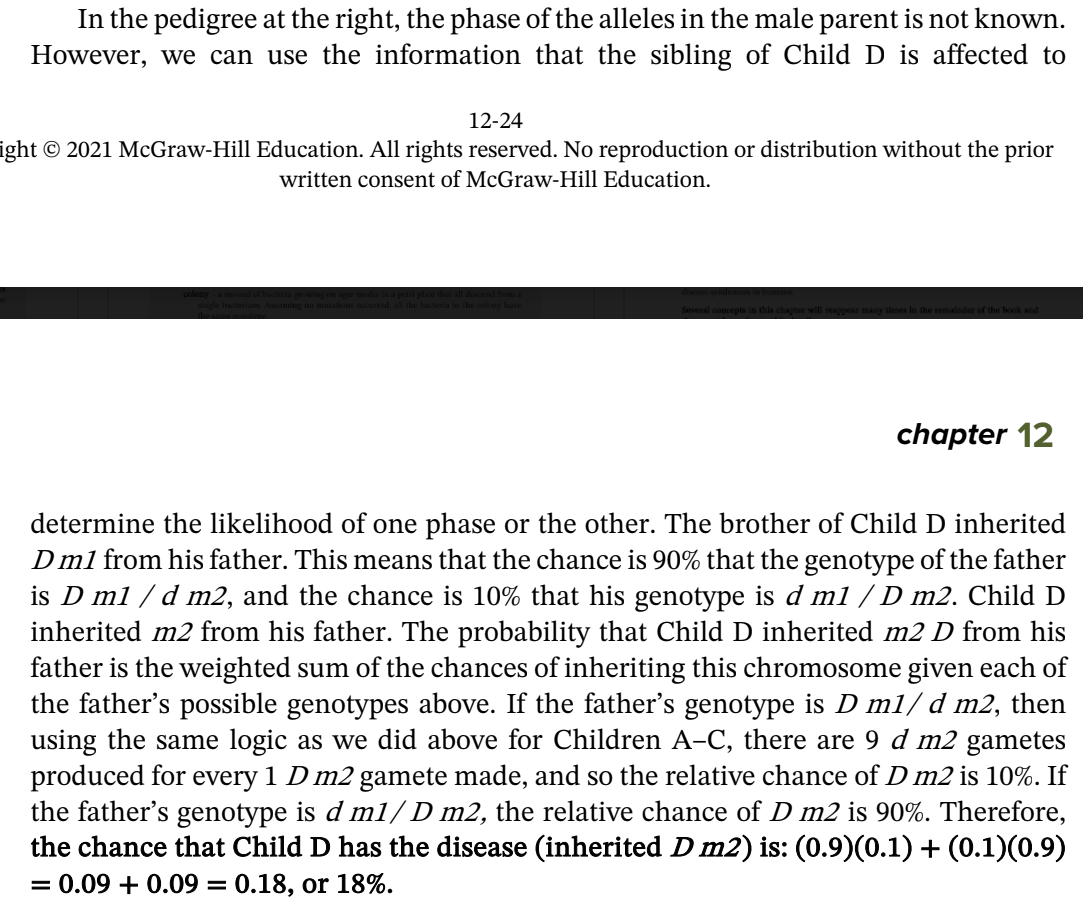12.37. The pedigrees indicated here were obtained with three unrelated families whose members express the same completely penetrant disease caused by a dominant mutation that is linked at a distance of 10 cM from an SSR marker locus with three alleles numbered 1, 2, and 3. The SSR alleles present within each live genotype are indicated below the pedigree symbol. The phenotypes of the newly born labeled individuals-A, B, C, and D-are unknown. a. What is the probability of disease expression in each of these newborn babies? b. Why would a human geneticist be unlikely to use this SSR marker for diagnosis of the genetic disease? 13 22 13 22 12 32 12 32 12 32 12 32 12 32 12 32
12.37. The pedigrees indicated here were obtained with three unrelated families whose members express the same completely penetrant disease caused by a dominant mutation that is linked at a distance of 10 cM from an SSR marker locus with three alleles numbered 1, 2, and 3. The SSR alleles present within each live genotype are indicated below the pedigree symbol. The phenotypes of the newly born labeled individuals-A, B, C, and D-are unknown. a. What is the probability of disease expression in each of these newborn babies? b. Why would a human geneticist be unlikely to use this SSR marker for diagnosis of the genetic disease? 13 22 13 22 12 32 12 32 12 32 12 32 12 32 12 32
Biology 2e
2nd Edition
ISBN:9781947172517
Author:Matthew Douglas, Jung Choi, Mary Ann Clark
Publisher:Matthew Douglas, Jung Choi, Mary Ann Clark
Chapter12: Mendel's Experiments And Heredity
Section: Chapter Questions
Problem 29CTQ: Why is it more efficient to perform a test cross with a homozygous recessive donor than a homozygous...
Related questions
Question
please explain why child D is 18% I don't understand the given explanation. explain thoroughly and in simple terms

Transcribed Image Text:12.37. The pedigrees indicated here were obtained with three unrelated families
whose members express the same completely penetrant disease caused by a
dominant mutation that is linked at a distance of 10 cM from an SSR marker
locus with three alleles numbered 1, 2, and 3. The SSR alleles present within
each live genotype are indicated below the pedigree symbol. The phenotypes of
the newly born labeled individuals-A, B, C, and D-are unknown.
a. What is the probability of disease expression in each of these newborn
babies?
b. Why would a human geneticist be unlikely to use this SSR marker for
diagnosis of the genetic disease?
13
22
13
22
12
32
12 32
12
32
12
32
12
32
12
32
A
D

Transcribed Image Text:In the pedigree at the right, the phase of the alleles in the male parent is not known.
However, we can use the information that the sibling of Child D is affected to
12-24
ight © 2021 McGraw-Hill Education. All rights reserved. No reproduction or distribution without the prior
written consent of McGraw-Hill Education.
chapter 12
determine the likelihood of one phase or the other. The brother of Child D inherited
Dml from his father. This means that the chance is 90% that the genotype of the father
is D ml / d m2, and the chance is 10% that his genotype is d m1 / D m2. Child D
inherited m2 from his father. The probability that Child D inherited m2 D from his
father is the weighted sum of the chances of inheriting this chromosome given each of
the father's possible genotypes above. If the father's genotype is D m1/ d m2, then
using the same logic as we did above for Children A-C, there are 9 d m2 gametes
produced for
the father's genotype is d m1/D m2, the relative chance of D m2 is 90%. Therefore,
the chance that Child D has the disease (inherited D m2) is: (0.9)(0.1) + (0.1)(0.9)
= 0.09 + 0.09 = 0.18, or 18%.
every
1 D m2 gamete made, and so the relative chance of D m2 is 10%. If
%3D
Expert Solution
This question has been solved!
Explore an expertly crafted, step-by-step solution for a thorough understanding of key concepts.
This is a popular solution!
Trending now
This is a popular solution!
Step by step
Solved in 2 steps

Knowledge Booster
Learn more about
Need a deep-dive on the concept behind this application? Look no further. Learn more about this topic, biology and related others by exploring similar questions and additional content below.Recommended textbooks for you

Biology 2e
Biology
ISBN:
9781947172517
Author:
Matthew Douglas, Jung Choi, Mary Ann Clark
Publisher:
OpenStax


Biology 2e
Biology
ISBN:
9781947172517
Author:
Matthew Douglas, Jung Choi, Mary Ann Clark
Publisher:
OpenStax
